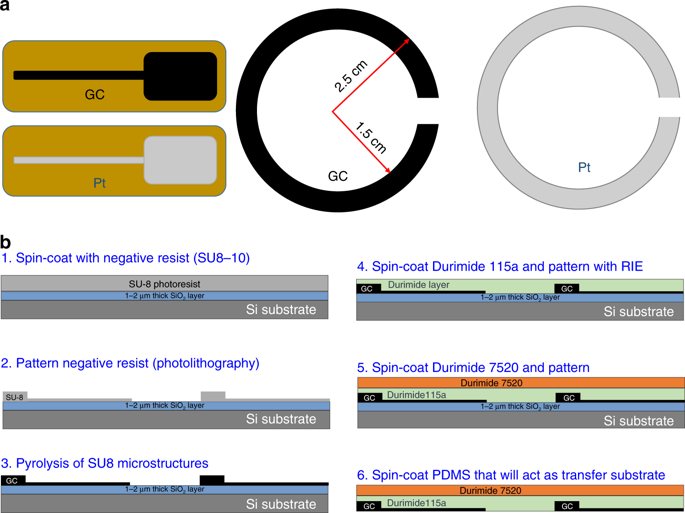Microsystems & Nanoengineering ( IF 7.9 ) Pub Date : 2019-11-18 , DOI: 10.1038/s41378-019-0106-x Surabhi Nimbalkar 1, 2 , Erwin Fuhrer 3 , Pedro Silva 3 , Tri Nguyen 1, 2 , Martin Sereno 4 , Sam Kassegne 1, 2 , Jan Korvink 3

|
The recent introduction of glassy carbon (GC) microstructures supported on flexible polymeric substrates has motivated the adoption of GC in a variety of implantable and wearable devices. Neural probes such as electrocorticography and penetrating shanks with GC microelectrode arrays used for neural signal recording and electrical stimulation are among the first beneficiaries of this technology. With the expected proliferation of these neural probes and potential clinical adoption, the magnetic resonance imaging (MRI) compatibility of GC microstructures needs to be established to help validate this potential in clinical settings. Here, we present GC microelectrodes and microstructures—fabricated through the carbon micro-electro-mechanical systems process and supported on flexible polymeric substrates—and carry out experimental measurements of induced vibrations, eddy currents, and artifacts. Through induced vibration, induced voltage, and MRI experiments and finite element modeling, we compared the performances of these GC microelectrodes against those of conventional thin-film platinum (Pt) microelectrodes and established that GC microelectrodes demonstrate superior magnetic resonance compatibility over standard metal thin-film microelectrodes. Specifically, we demonstrated that GC microelectrodes experienced no considerable vibration deflection amplitudes and minimal induced currents, while Pt microelectrodes had significantly larger currents. We also showed that because of their low magnetic susceptibility and lower conductivity, the GC microelectrodes caused almost no susceptibility shift artifacts and no eddy-current-induced artifacts compared to Pt microelectrodes. Taken together, the experimental, theoretical, and finite element modeling establish that GC microelectrodes exhibit significant MRI compatibility, hence demonstrating clear clinical advantages over current conventional thin-film materials, further opening avenues for wider adoption of GC microelectrodes in chronic clinical applications.
中文翻译:

玻碳微电极可最大限度地减少磁共振成像中的感应电压、机械振动和伪影
最近引入了支撑在柔性聚合物基材上的玻璃碳 (GC) 微结构,促使在各种可植入和可穿戴设备中采用 GC。用于神经信号记录和电刺激的皮质电描记术和具有 GC 微电极阵列的穿透小腿等神经探针是该技术的首批受益者之一。随着这些神经探针的预期扩散和潜在的临床采用,需要建立 GC 微结构的磁共振成像 (MRI) 兼容性,以帮助在临床环境中验证这种潜力。这里,我们展示了 GC 微电极和微结构——通过碳微机电系统工艺制造并支撑在柔性聚合物基板上——并对感应振动、涡流和伪影进行实验测量。通过感应振动、感应电压和 MRI 实验和有限元建模,我们将这些 GC 微电极的性能与传统薄膜铂 (Pt) 微电极的性能进行了比较,并确定 GC 微电极表现出优于标准金属薄膜的磁共振兼容性薄膜微电极。具体来说,我们证明 GC 微电极没有明显的振动偏转幅度和最小的感应电流,而 Pt 微电极具有明显更大的电流。我们还表明,由于其低磁化率和较低的电导率,与 Pt 微电极相比,GC 微电极几乎没有磁化率偏移伪影和涡流诱导伪影。总之,实验、理论和有限元模型确定 GC 微电极表现出显着的 MRI 兼容性,因此显示出优于当前传统薄膜材料的明显临床优势,进一步为在慢性临床应用中更广泛采用 GC 微电极开辟了道路。


























 京公网安备 11010802027423号
京公网安备 11010802027423号